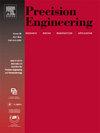Experimental study on surface finish and tool wear in ultrasonic vibration-assisted milling of nickel-based single-crystal superalloys
IF 3.5
2区 工程技术
Q2 ENGINEERING, MANUFACTURING
Precision Engineering-Journal of the International Societies for Precision Engineering and Nanotechnology
Pub Date : 2025-03-14
DOI:10.1016/j.precisioneng.2025.03.014
引用次数: 0
Abstract
Nickel-based single-crystal superalloys have emerged as the primary materials for a new generation of aero-engines, courtesy of their remarkable high-temperature performance, oxidation resistance, microstructure stability, and thermal fatigue resistance. Nevertheless, due to its inherent traits of high hardness and low thermal conductivity, the cutting performance is rather poor. In light of this, ultrasonic vibration and minimum quantity lubrication techniques are incorporated in this paper to assist in milling nickel-based single-crystal superalloy DD5 with the aim of improving the cutting quality and reducing tool wear, The findings reveal that under dry cutting conditions, although the surface roughness of ultrasonic vibration-assisted milling (UM) marginally escalates compared to that of conventional milling (CM), the surface defects are mitigated, and the scratch situation on the back of the chip is significantly alleviated. Moreover, as the cutting speed increments, the chip thickness diminishes. In contrast to UM and CM under dry cutting conditions, the thickness of the subsurface heat-affected layer after minimum quantity lubrication ultrasonic vibration assisted milling (UMQL) is the slightest at 2.0 μm, and in the UM processing under dry cutting conditions, as the cutting speed rises, the thickness of the affected layer marginally reduces. In the CM and UM processes under dry cutting conditions, tool failure occurred when the milling length reaches 0.9 m and 1.3 m respectively. Owing to the efficient cooling and lubricating effects of UMQL, when UMQL is employed for processing, the milling length of the tool can extend up to 2.1 m.
超声振动辅助铣削镍基单晶高温合金表面光洁度和刀具磨损试验研究
镍基单晶高温合金以其优异的高温性能、抗氧化性能、显微组织稳定性和抗热疲劳性能,已成为新一代航空发动机的主要材料。然而,由于其固有的高硬度和低导热性的特性,切削性能很差。基于此,本文采用超声振动和最小量润滑技术辅助铣削镍基单晶高温合金DD5,以提高切削质量和减少刀具磨损。研究结果表明,在干切削条件下,尽管超声振动辅助铣削(UM)的表面粗糙度与常规铣削(CM)相比略有上升,但表面缺陷有所减轻;芯片背面划伤的情况明显缓解。此外,随着切削速度的增加,切屑厚度减小。与干切削条件下的UM和CM相比,最少量润滑超声振动辅助铣削(UMQL)后的亚表面热影响层厚度在2.0 μm处最轻,并且在干切削条件下的UM加工中,随着切削速度的提高,影响层厚度略有减小。在干切削条件下,CM和UM工艺在铣削长度分别达到0.9 m和1.3 m时发生刀具失效。由于UMQL的有效冷却和润滑作用,当使用UMQL进行加工时,刀具的铣削长度可延长至2.1 m。
本文章由计算机程序翻译,如有差异,请以英文原文为准。
求助全文
约1分钟内获得全文
求助全文
来源期刊
CiteScore
7.40
自引率
5.60%
发文量
177
审稿时长
46 days
期刊介绍:
Precision Engineering - Journal of the International Societies for Precision Engineering and Nanotechnology is devoted to the multidisciplinary study and practice of high accuracy engineering, metrology, and manufacturing. The journal takes an integrated approach to all subjects related to research, design, manufacture, performance validation, and application of high precision machines, instruments, and components, including fundamental and applied research and development in manufacturing processes, fabrication technology, and advanced measurement science. The scope includes precision-engineered systems and supporting metrology over the full range of length scales, from atom-based nanotechnology and advanced lithographic technology to large-scale systems, including optical and radio telescopes and macrometrology.

 求助内容:
求助内容: 应助结果提醒方式:
应助结果提醒方式:


